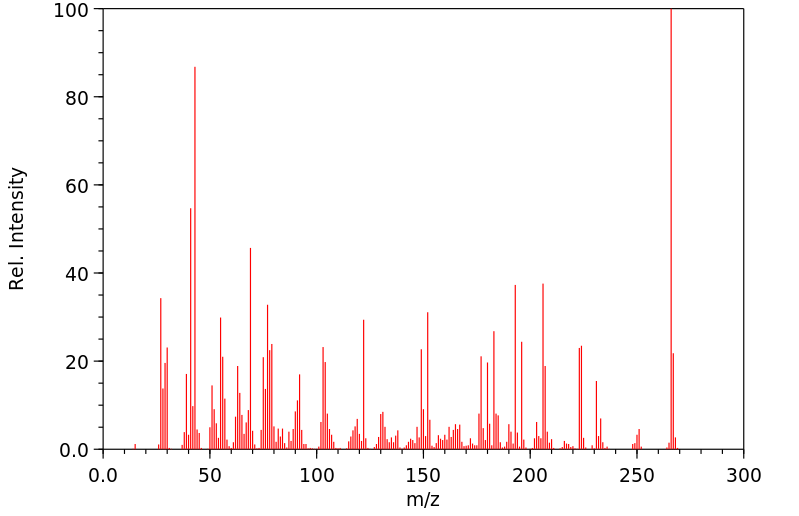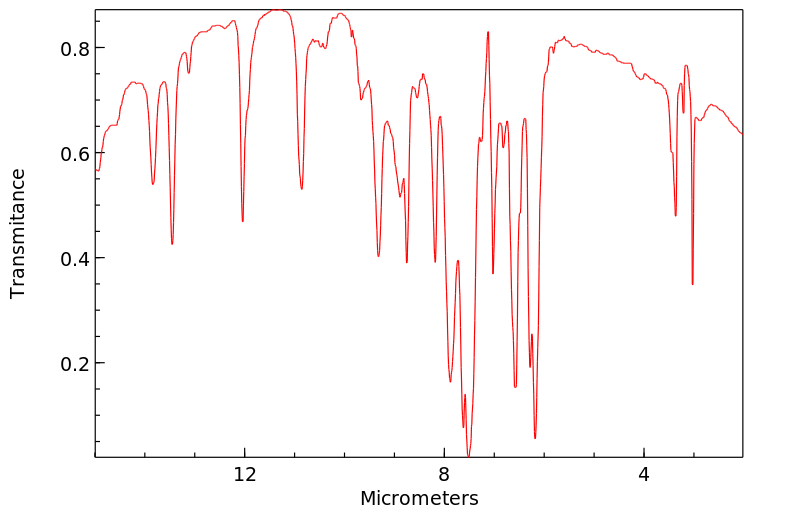2,4-二硝基苯腙异戊醛 | 2256-01-1
中文名称
2,4-二硝基苯腙异戊醛
中文别名
异戊醛-DNPH;异戊醛-2,4-二硝基苯腙;异戊醛2,4-二硝基苯腙
英文名称
isovaleraldehyde 2,4-dinitrophenylhydrazone
英文别名
3-methylbutanal (2,4-dinitrophenyl)hydrazone;isovaleraldehyde-(2,4-dinitro-phenylhydrazone);Isovaleraldehyd-(2,4-dinitro-phenylhydrazon);3-methyl-butanal, (2,4-dinitrophenyl)hydrazone;Isovaleraldehyd-2,4-dinitrophenylhydrazon;N-(3-methylbutylideneamino)-2,4-dinitroaniline
CAS
2256-01-1
化学式
C11H14N4O4
mdl
——
分子量
266.257
InChiKey
MCWYOPWJODIZJK-UHFFFAOYSA-N
BEILSTEIN
——
EINECS
——
-
物化性质
-
计算性质
-
ADMET
-
安全信息
-
SDS
-
制备方法与用途
-
上下游信息
-
文献信息
-
表征谱图
-
同类化合物
-
相关功能分类
-
相关结构分类
物化性质
-
熔点:122-124 °C(lit.)
-
保留指数:2410
计算性质
-
辛醇/水分配系数(LogP):2.1
-
重原子数:19
-
可旋转键数:4
-
环数:1.0
-
sp3杂化的碳原子比例:0.36
-
拓扑面积:116
-
氢给体数:1
-
氢受体数:6
安全信息
-
危险品标志:F,Xi,T
-
安全说明:S16,S26,S27,S36,S36/37,S45
-
危险类别码:R23/24/25,R36/37/38,R11,R43
-
WGK Germany:2,3
-
海关编码:2928000090
-
危险品运输编号:UN 1648 3/PG 2
-
储存条件:存储条件:0-6°C
SDS
Section I.Chemical Product and Company Identification
Chemical Name Isovaleraldehyde 2,4-Dinitrophenylhydrazone
(1mg/ml as Aldehyde in Ethyl Acetate) [for Offensive Odors Analysis] (1ml*5)
Portland OR
Synonym Not available.
Chemical Formula C11H14N4O4
CAS Number 2256-01-1
141-78-6 (Ethyl Acetate)
Section II. Composition and Information on Ingredients
Toxicology Data
Chemical Name CAS Number Percent (%) TLV/PEL
Isovaleraldehyde 2,4-Dinitrophenylhydrazone 0.11% Not available. (Ethyl Acetate)
2256-01-1
(1mg/ml as Aldehyde in Ethyl Acetate) [for Offensive Odors Analysis] (1ml*5)
141-78-6 (Ethyl 99.89% (Ethyl Rat LD50 (oral) 5620 mg/kg
Acetate) Mouse LD50 (oral) 4100 mg/kg
Acetate)
Rabbit LD50 (oral) 5500 mg/kg
Rabbit LD50 (dermal) >20 mL/kg
Rat LC50 (inhalation) 200 gm/m3
Mouse LC50 (inhalation) 45 gm/m3
Section III. Hazards Identification
Acute Health Effects Irritating to eyes and skin on contact. Inhalation causes irritation of the lungs and respiratory system. Inflammation of the
eye is characterized by redness, watering, and itching. Skin inflammation is characterized by itching, scaling, reddening,
or, occasionally, blistering.
Follow safe industrial hygiene practices and always wear proper protective equipment when handling this compound.
Chronic Health Effects CARCINOGENIC EFFECTS : Not available.
MUTAGENIC EFFECTS : Not available.
TERATOGENIC EFFECTS : Not available.
DEVELOPMENTAL TOXICITY: Not available.
Repeated or prolonged exposure to this compound is not known to aggravate existing medical conditions.
Section IV. First Aid Measures
Eye Contact Check for and remove any contact lenses. In case of contact, immediately flush eyes with plenty of water for at least 15
minutes. Get medical attention.
Skin Contact In case of contact, immediately flush skin with plenty of water. Remove contaminated clothing and shoes. Wash clothing
before reuse. Thoroughly clean shoes before reuse. Get medical attention.
Inhalation If the victim is not breathing, perform mouth-to-mouth resuscitation. Loosen tight clothing such as a collar, tie, belt or
waistband. If breathing is difficult, oxygen can be administered. Seek medical attention if respiration problems do not
improve.
Ingestion INDUCE VOMITING by sticking finger in throat. Lower the head so that the vomit will not reenter the mouth and throat.
Loosen tight clothing such as a collar, tie, belt or waistband. If the victim is not breathing, perform mouth-to-mouth
resuscitation. Examine the lips and mouth to ascertain whether the tissues are damaged, a possible indication that the
toxic material was ingested; the absence of such signs, however, is not conclusive.
Section V. Fire and Explosion Data
427°C (800.6°F) (Ethyl Acetate)
Auto-Ignition
Flammability Flammable.
Flammable Limits
Flash Points LOWER: 2.2% UPPER: 11.5% (Ethyl
-3°C (26.6°F). (Ethyl Acetate)
Acetate)
Combustion Products These products are toxic carbon oxides (CO, CO 2), nitrogen oxides (NO, NO2).
Fire Hazards
Not available.
Risks of explosion of the product in presence of mechanical impact: Not available.
Explosion Hazards
Risks of explosion of the product in presence of static discharge: Not available.
Continued on Next Page
Isovaleraldehyde 2,4-Dinitrophenylhydrazone
(1mg/ml as Aldehyde in Ethyl Acetate) [for Offensive Odors Analysis] (1ml*5)
Fire Fighting Media
Flammable liquid.
SMALL FIRE: Use DRY chemical powder.
and Instructions
LARGE FIRE: Use alcohol foam, water spray or fog.
Consult with local fire authorities before attempting large scale fire-fighting operations.
Section VI. Accidental Release Measures
Spill Cleanup Flammable material. Irritating material.
Keep away from heat. Mechanical exhaust required. Stop leak if without risk. Absorb with DRY earth, sand or other
Instructions
non-combustible material. DO NOT touch spilled material. Prevent entry into sewers, basements or confined areas; dike
if needed. Consult federal, state, and/or local authorities for assistance on disposal.
Section VII. Handling and Storage
Handling and Storage FLAMMABLE. IRRITANT. Keep away from heat. Mechanical exhaust required. Avoid excessive heat and light. Do not
breathe gas/fumes/ vapor/spray.
Information
Section VIII. Exposure Controls/Personal Protection
Engineering Controls Provide exhaust ventilation or other engineering controls to keep the airborne concentrations of vapors below their
respective threshold limit value. Ensure that eyewash station and safety shower is proximal to the work-station location.
Splash goggles. Lab coat. Vapor respirator. Boots. Gloves. Suggested protective clothing might not be sufficient;
Personal Protection
consult a specialist BEFORE handling this product. Be sure to use a MSHA/NIOSH approved respirator or equivalent.
Exposure Limits Not available.
Section IX. Physical and Chemical Properties
Physical state @ 20°C Liquid. Solubility
(Ethyl Acetate)
One ml dissolves in 10ml water at 25°;
0.9 (water=1) (Ethyl Acetate) more soluble at lower and less soluble at
Specific Gravity
higher temps.
Miscible with alcohol, acetone, chloroform,
ether.
Molecular Weight Partition Coefficient
266.25 Not available.
C4H8O2 =88.11 (Ethyl Acetate)
Boiling Point
76.5 to 77.5°C (169.7 to 171.5°F) (Ethyl Vapor Pressure 73 mmHg (@ 20°C) (Ethyl Acetate)
Acetate)
Melting Point -84°C (-119.2°F) (Ethyl Acetate) Vapor Density 3.04 (Air = 1) (Ethyl Acetate)
1.372 (Ethyl Acetate) Volatility Not available.
Refractive Index
Critical Temperature Odor Characteristic fruity odor (Ethyl Acetate)
Not available.
Viscosity Not available. Taste Not available.
Section X. Stability and Reactivity Data
This material is stable if stored under proper conditions. (See Section VII for instructions)
Stability
Conditions of Instability
Avoid excessive heat and light.
Incompatibilities
Reactive with strong oxidizing agents.
Section XI. Toxicological Information
RTECS Number AH5425000 (Ethyl Acetate)
Routes of Exposure Eye Contact. Ingestion. Inhalation.
(Ethyl Acetate)
Toxicity Data
Rat LD50 (oral) 5620 mg/kg
Mouse LD50 (oral) 4100 mg/kg
Rabbit LD50 (oral) 5500 mg/kg
Rabbit LD50 (dermal) >20 mL/kg
Rat LC50 (inhalation) 200 gm/m3
Mouse LC50 (inhalation) 45 gm/m3
Chronic Toxic Effects CARCINOGENIC EFFECTS : Not available.
MUTAGENIC EFFECTS : Not available.
TERATOGENIC EFFECTS : Not available.
DEVELOPMENTAL TOXICITY: Not available.
Repeated or prolonged exposure to this compound is not known to aggravate existing medical conditions.
Continued on Next Page
Isovaleraldehyde 2,4-Dinitrophenylhydrazone
(1mg/ml as Aldehyde in Ethyl Acetate) [for Offensive Odors Analysis] (1ml*5)
Acute Toxic Effects Irritating to eyes and skin on contact. Inhalation causes irritation of the lungs and respiratory system. Inflammation of the
eye is characterized by redness, watering, and itching. Skin inflammation is characterized by itching, scaling, reddening,
or, occasionally, blistering.
Follow safe industrial hygiene practices and always wear proper protective equipment when handling this compound.
Section XII. Ecological Information
Ecotoxicity Not available.
Environmental Fate soluble at lowe
Ethyl acetate's production and use as a pharmaceutic aid, in artificial fruit essences, and as a solvent may result in its
release to the environment through various waste streams. If released to air, a vapor pressure of 93 mm Hg at 25 deg C
indicates ethyl acetate will exist solely as a vapor in the ambient atmosphere. Vapor-phase ethyl acetate will be degraded
in the atmosphere by reaction with photochemically-produced hydroxyl radicals; the half-life for this reaction in air is
estimated to be 9.4 days. If released to soil, ethyl acetate is expected to have high mobility based upon an estimated Koc
of 59. Volatilization from moist soil surfaces is expected to occur based upon a Henry's Law constant of 1.34X10-4 atm-cu
m/mole. Ethyl acetate's vapor pressure indicates the potential for volatilization from dry soil surfaces exists.
Biodegradation is expected to be an important process in both soil and water, based upon ethyl acetate's biodegradation
in aqueous screening studies. 93% biodegradation was observed in a complete mix continuous-flow activated sludge
system. 26.6 and 57.1% of ethyl acetate's theoretical BOD was reached in 5 days using the standard dilution method and
seawater dilution method, respectively. If released into water, ethyl acetate is not expected to adsorb to suspended solids
and sediment in water based on the estimated Koc. Volatilization from water surfaces is expected to be an important fate
process based on ethyl acetate's Henry's Law constant. Estimated volatilization half-lives for a model river and model lake
are 8.9 hours and 5.6 days, respectively. An estimated BCF of 3.2 suggests the potential for bioconcentration in aquatic
organisms is low. Ethyl acetate's hydrolysis half-life at 25 deg C and pH 7 is 2.0 years. Occupational exposure to ethyl
acetate may occur through inhalation and dermal contact with this compound at workplaces where ethyl acetate is
produced or used or where adhesives, thinners, degreasers, paints, inks, and dome reagents are used. The general
population may be exposed to ethyl acetate via inhalation of ambient air, ingestion of food and drinking water, or dermal
contact with consumer products containing this compound.
Section XIII. Disposal Considerations
Waste Disposal Recycle to process, if possible. Consult your local regional authorities. You may be able to dissolve or mix material with a
combustible solvent and burn in a chemical incinerator equipped with an afterburner and scrubber system. Observe all
federal, state and local regulations when disposing of the substance.
Section XIV. Transport Information
DOT Classification DOT Class 9: Miscellaneous hazardous material
PIN Number
Proper Shipping Name
Chemical Kits
Packing Group (PG) III
DOT Pictograms
Section XV. Other Regulatory Information and Pictograms
TSCA Chemical Inventory This product is NOT on the EPA Toxic Substances Control Act (TSCA) inventory. The following notices are required by 40
CFR 720.36 (C) for those products not on the inventory list:
(EPA)
(i) These products are supplied solely for use in research and development by or under the supervision of a technically
qualified individual as defined in 40 CFR 720.0 et sec.
(ii) The health risks of these products have not been fully determined. Any information that is or becomes available will be
supplied on an MSDS sheet.
(Ethyl Acetate)
This compound is ON the EPA Toxic Substances Control Act (TSCA) inventory list.
WHMIS Classification CLASS B-2: Flammable liquid with a flash point lower than 37.8°C (100°F).
(Canada) On DSL (Ethyl Acetate)
EINECS Number (EEC) 205-500-4 (Ethyl Acetate)
EEC Risk Statements
R10- Flammable.
R18- In use, may form flammable/explosive vapor-air mixture.
R36/37/38- Irritating to eyes, respiratory system and skin.
Japanese Regulatory Data
ENCS No. 2-726 (Ethyl Acetate)
Continued on Next Page
Isovaleraldehyde 2,4-Dinitrophenylhydrazone
(1mg/ml as Aldehyde in Ethyl Acetate) [for Offensive Odors Analysis] (1ml*5)
SECTION 16 - ADDITIONAL INFORMATION
N/A
上下游信息
-
上游原料
中文名称 英文名称 CAS号 化学式 分子量 2,4-二硝基苯肼 (2,4-dinitro-phenyl)-hydrazine 119-26-6 C6H6N4O4 198.138
反应信息
-
作为产物:描述:2,4,7-trimethyl-oct-2-en-4-ol 在 lead(IV) acetate 、 过氧乙酸 、 乙醚 、 magnesium sulfate 、 溶剂黄146 作用下, 生成 2,4-二硝基苯腙异戊醛参考文献:名称:Pansewitsch-Koljada et al., Sb. Statei Obshch. Khim., 1953, p. 1418,1425摘要:DOI:
文献信息
-
A Novel Cleavage of Five-Membered Cyclic Acetals Using Sodium Hydrogen Telluride
-
Richter, Biochemical Journal, 1937, vol. 31, p. 2022,2026作者:RichterDOI:——日期:——
-
Anderson; Le Fevre; Savage, Journal of the Chemical Society, 1947, p. 449作者:Anderson、Le Fevre、SavageDOI:——日期:——
表征谱图
-
氢谱1HNMR
-
质谱MS
-
碳谱13CNMR
-
红外IR
-
拉曼Raman
-
峰位数据
-
峰位匹配
-
表征信息
同类化合物
(βS)-β-氨基-4-(4-羟基苯氧基)-3,5-二碘苯甲丙醇
(S,S)-邻甲苯基-DIPAMP
(S)-(-)-7'-〔4(S)-(苄基)恶唑-2-基]-7-二(3,5-二-叔丁基苯基)膦基-2,2',3,3'-四氢-1,1-螺二氢茚
(S)-盐酸沙丁胺醇
(S)-3-(叔丁基)-4-(2,6-二甲氧基苯基)-2,3-二氢苯并[d][1,3]氧磷杂环戊二烯
(S)-2,2'-双[双(3,5-三氟甲基苯基)膦基]-4,4',6,6'-四甲氧基联苯
(S)-1-[3,5-双(三氟甲基)苯基]-3-[1-(二甲基氨基)-3-甲基丁烷-2-基]硫脲
(R)富马酸托特罗定
(R)-(-)-盐酸尼古地平
(R)-(-)-4,12-双(二苯基膦基)[2.2]对环芳烷(1,5环辛二烯)铑(I)四氟硼酸盐
(R)-(+)-7-双(3,5-二叔丁基苯基)膦基7''-[((6-甲基吡啶-2-基甲基)氨基]-2,2'',3,3''-四氢-1,1''-螺双茚满
(R)-(+)-7-双(3,5-二叔丁基苯基)膦基7''-[(4-叔丁基吡啶-2-基甲基)氨基]-2,2'',3,3''-四氢-1,1''-螺双茚满
(R)-(+)-7-双(3,5-二叔丁基苯基)膦基7''-[(3-甲基吡啶-2-基甲基)氨基]-2,2'',3,3''-四氢-1,1''-螺双茚满
(R)-(+)-4,7-双(3,5-二-叔丁基苯基)膦基-7“-[(吡啶-2-基甲基)氨基]-2,2”,3,3'-四氢1,1'-螺二茚满
(R)-3-(叔丁基)-4-(2,6-二苯氧基苯基)-2,3-二氢苯并[d][1,3]氧杂磷杂环戊烯
(R)-2-[((二苯基膦基)甲基]吡咯烷
(R)-1-[3,5-双(三氟甲基)苯基]-3-[1-(二甲基氨基)-3-甲基丁烷-2-基]硫脲
(N-(4-甲氧基苯基)-N-甲基-3-(1-哌啶基)丙-2-烯酰胺)
(5-溴-2-羟基苯基)-4-氯苯甲酮
(5-溴-2-氯苯基)(4-羟基苯基)甲酮
(5-氧代-3-苯基-2,5-二氢-1,2,3,4-oxatriazol-3-鎓)
(4S,5R)-4-甲基-5-苯基-1,2,3-氧代噻唑烷-2,2-二氧化物-3-羧酸叔丁酯
(4S,4''S)-2,2''-亚环戊基双[4,5-二氢-4-(苯甲基)恶唑]
(4-溴苯基)-[2-氟-4-[6-[甲基(丙-2-烯基)氨基]己氧基]苯基]甲酮
(4-丁氧基苯甲基)三苯基溴化磷
(3aR,8aR)-(-)-4,4,8,8-四(3,5-二甲基苯基)四氢-2,2-二甲基-6-苯基-1,3-二氧戊环[4,5-e]二恶唑磷
(3aR,6aS)-5-氧代六氢环戊基[c]吡咯-2(1H)-羧酸酯
(2Z)-3-[[(4-氯苯基)氨基]-2-氰基丙烯酸乙酯
(2S,3S,5S)-5-(叔丁氧基甲酰氨基)-2-(N-5-噻唑基-甲氧羰基)氨基-1,6-二苯基-3-羟基己烷
(2S,2''S,3S,3''S)-3,3''-二叔丁基-4,4''-双(2,6-二甲氧基苯基)-2,2'',3,3''-四氢-2,2''-联苯并[d][1,3]氧杂磷杂戊环
(2S)-(-)-2-{[[[[3,5-双(氟代甲基)苯基]氨基]硫代甲基]氨基}-N-(二苯基甲基)-N,3,3-三甲基丁酰胺
(2S)-2-[[[[[((1S,2S)-2-氨基环己基]氨基]硫代甲基]氨基]-N-(二苯甲基)-N,3,3-三甲基丁酰胺
(2S)-2-[[[[[[((1R,2R)-2-氨基环己基]氨基]硫代甲基]氨基]-N-(二苯甲基)-N,3,3-三甲基丁酰胺
(2-硝基苯基)磷酸三酰胺
(2,6-二氯苯基)乙酰氯
(2,3-二甲氧基-5-甲基苯基)硼酸
(1S,2S,3S,5S)-5-叠氮基-3-(苯基甲氧基)-2-[(苯基甲氧基)甲基]环戊醇
(1S,2S,3R,5R)-2-(苄氧基)甲基-6-氧杂双环[3.1.0]己-3-醇
(1-(4-氟苯基)环丙基)甲胺盐酸盐
(1-(3-溴苯基)环丁基)甲胺盐酸盐
(1-(2-氯苯基)环丁基)甲胺盐酸盐
(1-(2-氟苯基)环丙基)甲胺盐酸盐
(1-(2,6-二氟苯基)环丙基)甲胺盐酸盐
(-)-去甲基西布曲明
龙蒿油
龙胆酸钠
龙胆酸叔丁酯
龙胆酸
龙胆紫-d6
龙胆紫








